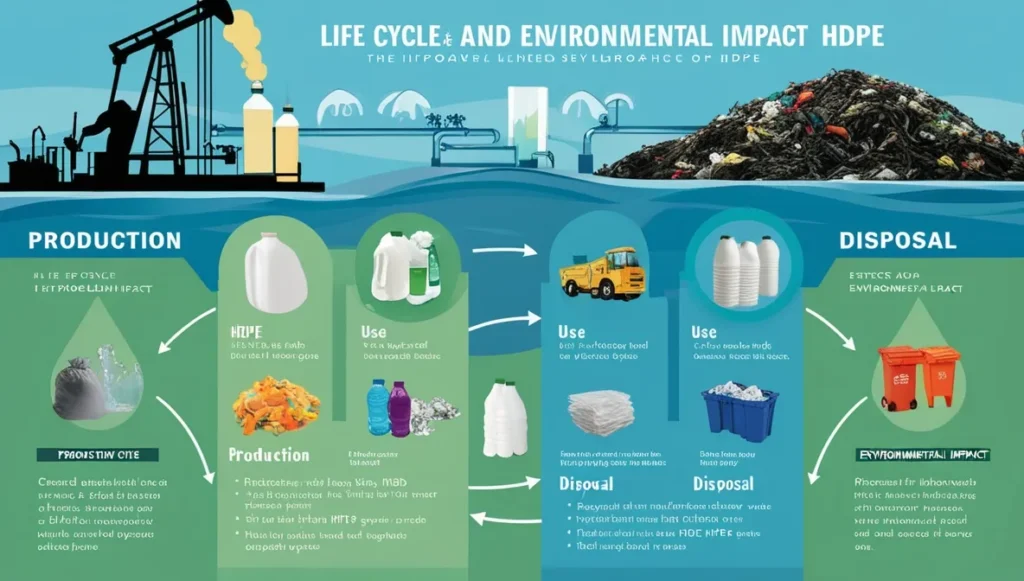Introduction
Here we are discussing about The Environmental Impact of HDPE.
- Overview of HDPE: Briefly introduce HDPE as a type of plastic widely used in various applications such as packaging, piping, and containers. Explain its benefits, such as durability, lightweight nature, and low cost.
- Environmental Impact Significance: Describe why understanding HDPE’s environmental impact is crucial, especially for environmentally conscious readers in the USA and UK.
- Intent of Article: Inform readers about HDPE’s environmental footprint, disposal challenges, recycling possibilities, and sustainable alternatives.
What is HDPE?
- Definition and Properties: Explain HDPE (High-Density Polyethylene) as a thermoplastic polymer, its molecular structure, and properties that make it resistant to heat and impact.
- Common Uses of HDPE: Outline popular applications in packaging (e.g., milk jugs, detergent bottles), construction, and piping.
The Environmental Impact of HDPE
HDPE Production Process and Resource Consumption
- Petroleum-Based Material: Describe how HDPE is primarily made from fossil fuels, such as natural gas and petroleum, requiring significant energy and natural resources.
- Emissions and Pollution: Outline greenhouse gas emissions during production, along with water and air pollution concerns.
Non-Biodegradability and Long Decomposition Time
- Longevity of HDPE in the Environment: Discuss HDPE’s estimated decomposition time of 450-1000 years.
- Impact on Ecosystems: Explain how HDPE waste can disrupt ecosystems, harm marine life, and contribute to global pollution issues.
Microplastics Problem
- Breakdown into Microplastics: Describe how HDPE doesn’t fully degrade but rather breaks down into smaller particles, contributing to microplastic pollution.
- Human Health Risks: Link microplastic pollution to potential health risks in humans and animals, given HDPE particles can enter food and water supplies.
HDPE Waste Management and Recycling
Current Recycling Rates and Practices
- Global and Regional Recycling Data (Table)
| Region | Recycling Rate (%) | Key Issues |
|---|---|---|
| USA | ~30% | Limited infrastructure |
| UK | ~33% | Export dependence, quality issues |
- Recycling Challenges: Explain barriers to recycling HDPE, such as sorting difficulties and contamination.
Environmental Benefits of HDPE Recycling
- Reduced Emissions and Energy Savings: Show how recycling HDPE can reduce emissions and lower the demand for virgin plastic.
- Recycling Process Overview: Describe the HDPE recycling process, from collection to reprocessing.
Limitations of HDPE Recycling
- Downcycling vs. Closed-Loop Recycling: Explain why HDPE is often downcycled into lower-grade products, which limits its lifecycle.
- Loss of Material Quality: Address how the quality of recycled HDPE may degrade after each cycle.
Also Read: About HDPE Pipes
Sustainability and Alternatives to HDPE
Biodegradable and Compostable Alternatives
- Bioplastics Overview: Describe compostable bioplastics, such as PLA, and their environmental benefits compared to HDPE.
- Pros and Cons: Compare the environmental impacts and functionality of bioplastics and HDPE.
Reusable and Durable Alternatives
- Metal and Glass Alternatives: Explore how glass and metal options can serve as durable, eco-friendly replacements in certain applications.
- Cost and Practicality: Discuss the economic feasibility and practicality of replacing HDPE with alternative materials.
Government Policies and Corporate Initiatives
- USA and UK Regulations on Plastic Waste: Describe current policies, such as single-use plastic bans and recycling mandates, that affect HDPE use.
- Corporate Efforts and Innovations: Highlight companies adopting HDPE alternatives, eco-friendly packaging, or recycling initiatives.
Consumer Role in Reducing HDPE Impact
- Steps to Reduce HDPE Use: List practical ways consumers can reduce HDPE consumption, such as using reusable containers, supporting brands with sustainable packaging, and recycling.
- Eco-Friendly Purchasing Decisions: Advise consumers on choosing brands that prioritize sustainability and encourage sustainable packaging.
Frequently Asked Questions (FAQs)
What is HDPE and why is it used?
HDPE, or High-Density Polyethylene, is a strong, durable type of plastic commonly used in products like plastic bottles, pipes, and packaging materials. It’s valued for its resistance to impact, moisture, and chemicals, making it ideal for applications where durability is key. HDPE is lightweight, cost-effective, and can withstand extreme temperatures, which makes it one of the most popular plastics in the world.
How long does HDPE take to decompose?
HDPE is non-biodegradable, meaning it does not break down into natural elements within a human lifetime. Estimates suggest that HDPE can take between 450 and 1,000 years to fully decompose in the environment. During this time, it can fragment into smaller pieces, known as microplastics, which persist in ecosystems and pose a risk to wildlife and human health.
Is HDPE recyclable in the USA and UK?
Yes, HDPE is recyclable and is classified as a #2 plastic. The recycling process for HDPE involves collecting, sorting, and melting down the plastic for reuse in new products. However, recycling rates vary by region, with the USA and UK recycling around 30-33% of HDPE waste. Recycling HDPE reduces the need for new plastic production, saving energy and lowering greenhouse gas emissions, but challenges like contamination and quality loss limit the overall effectiveness.
What are the environmental risks of HDPE?
HDPE production is resource-intensive, using petroleum and natural gas, which contributes to greenhouse gas emissions. When discarded, HDPE products often end up in landfills or oceans, where they break down into microplastics. These microplastics harm marine life, contaminate ecosystems, and can enter the human food chain, leading to potential health risks. Additionally, HDPE’s long decomposition time means it accumulates in the environment, exacerbating plastic pollution.
Are there sustainable alternatives to HDPE?
Yes, there are several alternatives to HDPE, including bioplastics made from renewable resources like corn starch (e.g., PLA) and reusable materials like metal or glass. Bioplastics are biodegradable under specific conditions, which can reduce their environmental impact. Reusable containers made from materials like stainless steel or glass can also replace HDPE in many applications, though they may be more costly and heavier.
Conclusion
- Recap of HDPE’s Environmental Impact: Summarize the key points, including HDPE’s environmental footprint, recycling limitations, and sustainability challenges.
- Encouragement for Eco-Friendly Choices: Encourage readers to make eco-friendly decisions regarding HDPE and other plastics to support a healthier planet.
